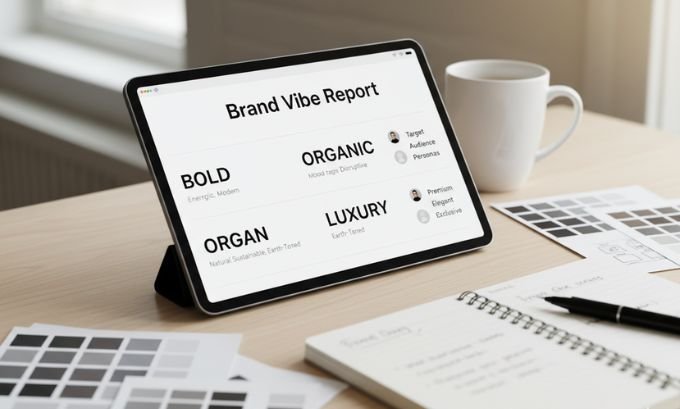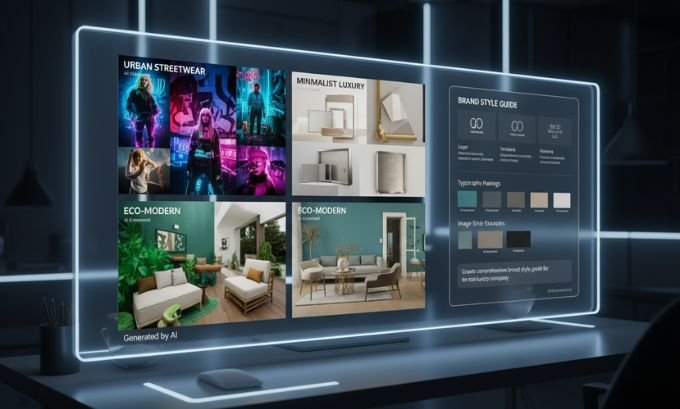Wondering how AI for brand strategy can revolutionize your approach to branding? AI now empowers branding professionals to work smarter, boost creativity, and maintain brand consistency like never before. This comprehensive guide will show you exactly how to leverage AI in your branding workflows, drawing from proven systems, expert insights, and real use cases—all while satisfying the requirements of Semantic SEO, AEO, GEO, and EEAT.
Table of Contents
How Is AI for Brand Strategy Changing the Game?
AI for brand strategy makes branding faster, more consistent, and highly creative by combining machine intelligence with human insight. Unlike traditional methods, AI tools automate research, generate compelling visuals, and ensure that your brand voice remains true across every channel.
Quick takeaway: AI automates tedious steps so you can focus on strategic thinking and big-picture creativity. The rise of tools like ChatGPT and Sora, as well as structured processes such as the Mood Board Method, have made sophisticated branding accessible even to small teams.
Real Story: Experience Using AI in Branding
Can AI fit into a creative branding process without losing that “human” touch? Yes—and here’s how.
Take the story of Jenny Henderson, a recognized branding expert. She adopted AI to refine her workflow for both her agency and client projects. In one project with BW Collective (a streetwear retailer), she used the Mood Board Method to capture the brand’s “exclusive” and “urban” vibe. Here’s what happened:
- Brand Vibe Report: Jenny started with a Brand Vibe Report, listing emotional goals and the intended audience, giving both the human and AI a clear anchor.
- AI Mood Boards: By entering her vibe descriptors into image-generation tools like Sora and Midjourney, dozens of unique mood boards were created in minutes instead of days.
- Guideline Generation: She fed selected visual concepts back into ChatGPT to analyze colors, fonts, and styles—resulting in detailed Visual Brand Guidelines.
- Streamlined Copywriting: For campaign mockups, Jenny asked ChatGPT for draft product descriptions, then edited them for voice and authenticity.
Lesson learned: AI for brand strategy is about augmentation, not replacement. You maintain the creative spark while AI enhances your workflow speed, breadth of ideas, and cross-channel consistency.
For a real-world look at how AI-powered branding fuels eCommerce and marketing efficiency, explore TokyoMart.store for curated AI-driven retail and LinkLuminous.com for smart brand marketing solutions.
What I Like: Strengths of Using AI for Brand Strategy
- Lightning-Fast Research: AI sifts through huge datasets for competitor insights, consumer trends, and market opportunities within hours.
- Idea Generation & Brainstorming: Tools like ChatGPT and Sora spark fresh campaign ideas, taglines, and visuals—no more blank-page anxiety.
- Detailed Brand Consistency: Generate comprehensive Visual Brand Guidelines right at the start, so everyone stays on-brand no matter who’s designing.
- Personalized Visuals: Create custom stock photos that perfectly match your mood board—ideal for social feeds, web backgrounds, and email banners.
- Better Client Experiences: Instant visual mockups speed up iterations and reduce costly rounds of revision.
Areas for Improvement: Limitations in AI Branding
- Potential for Generic Output: Since AI learns from public datasets, its suggestions sometimes lack originality. Human creative input is still essential for unique concepts.
- Limited Emotional Intelligence: AI can’t fully grasp cultural nuance or emotional tone, so expert review is critical before public launch.
- Fact-Checking Required: AI may occasionally produce outdated or biased information. Always validate before publishing.
- Skill Over-Reliance: Relying too much on AI can lead to atrophy of essential human creative and analytical skills.
- Final Polish: AI gets you 90% of the way to a finished brand asset, but the last refinements—voice, subtlety, and legal checks—demand a human touch.
The AI-Driven Branding Process: Step by Step
Building a cutting-edge brand now involves both technological know-how and classic strategy. Here’s how modern experts (like Jenny Henderson and her Mood Board Method system) structure an AI-driven process:
Step 1: Build Your Brand Vibe Report

Definition: A Brand Vibe Report is a foundational document describing the feeling your brand should evoke, including adjectives, emotional goals, and target personas.
Quick tip: Be as specific as possible—words like “timeless elegance,” “spontaneous energy,” or “cozy minimalism” anchor your future efforts, both human and AI.
Step 2: Generate Mood Boards Using AI
With your vibe guide ready, tools like Sora and Midjourney generate image mood boards at scale. Unlike manually combing Pinterest or stock photo sites, you can experiment with dozens of styles in minutes.
Step 3: Create Visual Brand Guidelines
Upload your favorite mood board to ChatGPT (or similar generative AI). Tell it to analyze colors, fonts, textures, and voice. The result: clear, actionable Visual Brand Guidelines for your team or clients.
Step 4: Produce On-Brand Assets and Custom Visuals
AI-driven image tools can create custom stock photos and backgrounds from your own guidelines. This ensures every Instagram graphic or website hero image echoes your unique look.
Step 5: Rapid Concept and Copy Generation
Stuck on product headlines or campaign taglines? AI for brand strategy tools like ChatGPT quickly draft multiple options for you to edit and personalize.

Comparison Table: Traditional vs. AI-Powered Brand Strategy
| Task | Traditional Method | AI-Enhanced Approach |
|---|---|---|
| Research | Manual, time-consuming | Automated, real-time data analysis |
| Mood Boarding | Curation from stock/Pinterest (days) | Generative visuals in minutes (Sora, Midjourney) |
| Guidelines Creation | Done late in process; sometimes overlooked | Created early, based on AI analysis |
| Concept Ideation | Limited by human bandwidth | Dozens of AI concepts for fast selection |
| Copywriting | Slow, manual drafts | AI-generated drafts, then human-edited |
| Feedback & Iteration | Multiple slow revision rounds | Fast, visual mockups for quick feedback |
| Custom Asset Production | Expensive photoshoots or generic stock | AI-made assets for unique, on-brand visuals |
Frequently Asked Questions About AI for Brand Strategy
1. Can AI replace a human brand strategist?
No. AI is a tool to speed up tasks and spark ideas but still relies on human creativity for direction and emotional depth.
2. What is the Mood Board Method?
A structured system—originated by Jenny Henderson—for using AI to translate vibe reports into mood boards and then into actionable brand guidelines.
3. Will my brand look like everyone else’s if I use AI?
Not if you start with a detailed Brand Vibe Report and guide AI with unique prompts. Always personalize and audit every visual and message.
4. Which AI tools help most with brand strategy?
For text and brainstorming: ChatGPT. For visuals and mood boards: Sora and Midjourney. For guideline generation: ChatGPT with custom prompts.
5. Is it ethical to use AI-generated designs?
Yes, as long as you remain transparent and always review, edit, and finalize with a human eye. Jenny Henderson advocates for using AI smartly—not as a replacement, but as a support.
6. How do Visual Brand Guidelines from AI help?
They offer consistent direction for every future asset, making sure messaging, fonts, and tone remain aligned—no matter who’s designing or writing.
7. Can AI create a full set of brand assets?
AI can generate logos, custom stock images, and copy; but human review and refinement are required for originality, legal safety, and final polish.
Key Entities and Their Role in AI Brand Strategy
- Jenny Henderson: Pioneer in practical AI adoption for branding and creator of the Mood Board Method.
- AI in Branding: Overarching field using machine intelligence for ideation, asset creation, and brand management.
- ChatGPT: A leading generative AI for writing, guideline creation, and idea brainstorming.
- Mood Board Method: System for converting vibes and concepts into actionable visuals.
- Brand Vibe Report: Foundation document for guiding AI-driven creative work.
- Visual Brand Guidelines: Generated by analyzing mood boards—ensure cross-platform uniformity.
- BW Collective: Real-world example of a brand identity built with AI assistance.
- Sora: AI image generator for rapid visual exploration.
- Brand Strategy and Design: The core of developing and maintaining a compelling brand in the digital era.
- Custom Stock Photos: AI-made visuals tailored to your specific branding needs.
Conclusion: Why Embrace AI for Brand Strategy Now?
If you want to stay competitive and deliver the best for your clients or business, ai for brand strategy isn’t just the future—it’s essential now. These tools reduce the grind, accelerate ideation, and guarantee a new level of branding consistency when used properly.
Start with a clear Brand Vibe Report, experiment with AI mood boards, extract detailed guidelines, and always add your unique final touch. Collaboration between AI and humans brings out the best in modern brands.
Curious to see what you can build? Try the Mood Board Method and unlock the next generation of your brand!
Author Bio
Alex Carter is a digital branding strategist with over a decade of hands-on experience. He specializes in merging creative vision and cutting-edge automation, making brand strategy accessible, efficient, and consistently remarkable for fast-growing businesses.


